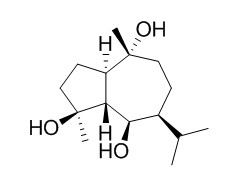Teuclatriol
Teuclatriol was found to be one of the compounds responsible for the immunoinhibitory effect of Salvia mirzayanii, by inhibiting NF-κB signaling at doses of 312µM and higher. It showed a significant anti-proliferative effect on human activated-peripheral blood lymphocytes (IC50, 72.8 ± 5.4 µg/ml).
Inquire / Order:
manager@chemfaces.com
Technical Inquiries:
service@chemfaces.com
Tel:
+86-27-84237783
Fax:
+86-27-84254680
Address:
1 Building, No. 83, CheCheng Rd., Wuhan Economic and Technological Development Zone, Wuhan, Hubei 430056, PRC
Providing storage is as stated on the product vial and the vial is kept tightly sealed, the product can be stored for up to
24 months(2-8C).
Wherever possible, you should prepare and use solutions on the same day. However, if you need to make up stock solutions in advance, we recommend that you store the solution as aliquots in tightly sealed vials at -20C. Generally, these will be useable for up to two weeks. Before use, and prior to opening the vial we recommend that you allow your product to equilibrate to room temperature for at least 1 hour.
Need more advice on solubility, usage and handling? Please email to: service@chemfaces.com
The packaging of the product may have turned upside down during transportation, resulting in the natural compounds adhering to the neck or cap of the vial. take the vial out of its packaging and gently shake to let the compounds fall to the bottom of the vial. for liquid products, centrifuge at 200-500 RPM to gather the liquid at the bottom of the vial. try to avoid loss or contamination during handling.
Drug Des Devel Ther.2020, 14:969-976.
Food Res Int.2024, 191:114613.
Front Microbiol.2022, 12:833233.
Jour. of Stored Pro & Postharvest Res.2016, 7(3):32-36
Heliyon.2023, 9(11):e21944.
Research Square2024, 4805471.
Tumour Biol.2015, 36(9):7027-34
Herbal Formula Science2024, 32(3):203-221
Nutrients.2019, 11(6):E1380
Int. Conference on Med. Sci. and Bio.2017, 17973
Related and Featured Products
J Ethnopharmacol. 2015 Feb 3;160:94-100.
Inhibitory effects of teuclatriol, a sesquiterpene from salvia mirzayanii, on nuclear factor-κB activation and expression of inflammatory mediators.[Pubmed:
25446581]
Salvia mirzayanii Rech. f. & Esfand. is an endemic plant, which is only distributed in the south of Iran. In traditional Iranian medicine, the aerial parts of Salvia mirzayanii have been used for infections, inflammatory diseases, and as a tonic. From this plant, the sesquiterpene Teuclatriol was isolated by bioactivity-guided fractionation due to its anti-proliferative actions on human lymphocytes. The guaiane sesquiterpene is lacking the methylene-γ-lactone function that is typically involved in the inhibiting properties of sesquiterpenes on NF-κB, a pivotal transcription factor in inflammatory processes. We here investigated anti-inflammatory effects of Teuclatriol on human macrophage-like and endothelial cells.
METHODS AND RESULTS:
Non-toxic doses of Teuclatriol were determined for both cell types by MTT (3-(4,5-dimethylthiazol-2-yl)-2,5-diphenyltetrazolium bromide)-assay. The effect of Teuclatriol on the activity of NF-κB in LPS-stimulated human monocytic THP-1 cells was studied using infrared electrophoretic mobility shift assay (IR-EMSA) using curcumin as positive control (32µM). THP-1 were differentiated into macrophage-like cells and evaluated for TNF-α secretion by L929 bioassay following stimulation with LPS and treatment with Teuclatriol. Inflammatory gene expression in human umbilical vein endothelial cells (HUVEC), modeling target cells for TNF-α-induced inflammatory gene activation, was investigated by real-time RT-PCR.The LPS-induced DNA binding activity of NF-κB in THP-1 was significantly decreased by non-toxic doses of Teuclatriol (312 and 390µM). Teuclatriol reduced the production of TNF-α in a dose-dependent manner. mRNA levels of both monocyte chemoattractant protein (MCP)-1 and toll-like receptor (TLR)2 were decreased in TNF-α-activated HUVEC.
CONCLUSIONS:
These data show an inhibitory effect of Teuclatriol on NF-κB signaling at doses of 312µM and higher, validating the traditional use of Salvia mirzayanii in the treatment of inflammatory diseases. Future work on the mode of action of Teuclatriol may provide new lead structures with NF-κB inhibiting properties, lacking possible side effects mediated via alkylating centers of sesquiterpene lactones.
Iran J Immunol. 2011 Dec;8(4):226-35.
Immunoinhibitory effect of teuclatriol a guaiane sesquiterpene from Salvia mirzayanii.[Pubmed:
22201620 ]
Salvia mirzayanii, a native plant to Iran, is shown to have immunomodulatory effects on lymphocyte proliferation. To identify the bioactive immunomodulatory compound(s) present in S. mirzayanii.
METHODS AND RESULTS:
The crude extract was fractionated to five fractions in two steps using different solvents. The fractions were subjected to bioassay-guided fractionation. All the fractions were tested for bioactivity on human activated-peripheral blood lymphocytes (PBLs) using cell proliferation assay. The methanol fraction (Fr. M) showed the highest inhibitory effect on PBLs compared to other fractions. Fr. M was applied on a gravity column chromatography for further fractionation. Resultant fractions, demonstrated inhibitory effects at higher concentrations. Fr. 4 with an 18.9 ± 0.2% inhibitory activity at 200 µg/ml and with the highest quantity was applied on preparative TLC plates for further purification. The final purified compound was identified as Teuclatriol, a guaiane sesquiterpene, by NMR analysis. This compound showed a significant anti-proliferative effect on human activated-peripheral blood lymphocytes (IC50, 72.8 ± 5.4 µg/ml).
CONCLUSIONS:
Teuclatriol was found to be one of the compounds responsible for the immunoinhibitory effect of Salvia mirzayanii. We suggest further studies on Teuclatriol, exploring its mechanism of action as an immunomodulatory compound.
Zhongguo Zhong Yao Za Zhi. 2012 Nov;37(22):3430-3.
[Chemical constituents of Acorus calamus].[Pubmed:
23373216]
To study the chemical constituents contained in Acorus calamus.
METHODS AND RESULTS:
The chemical constituents were separated and purified by various chromatographic methods including silica gel, ODS, HPLC and Sephadex LH-20, and their structures were identified on the basis of analysis on spectroscopic data. Ten compounds were separated from A. calamus and identified as 1beta, 4beta, 7alpha-trihydroxyeudesmane (1), bullatantriol (2), Teuclatriol (3), threo-1', 2'-dihydroxyasarone (4), erythro-1', 2'-dihydroxyasarone (5), (+)-de-4'-O-methyleudesmin (6), (+)-de-4'-0-methylmagnolin (7), (+)-eudesmin (8), (+)-magnolin (9) and beta-sitosterol (10), respectively.
METHODS AND RESULTS:
Compounds 1-2,4-9 were separated from this plant for the first time. Specifically, compounds 1-2,6-9 were obtained from Acorus genus for the first time.



